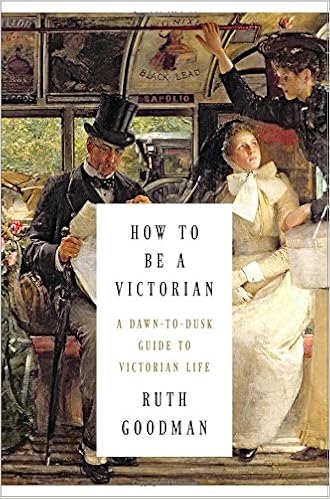Tuesday, September 1, 2015
Book Review: How To Be A Victorian
In addition to cooking delicious historic food, Elise also has excellent book recommendations: case in point, How to be a Victorian by Ruth Goodman.
[For those unacquainted with the author, Ms. Goodman is the domestic historian who appeared in the BBC's Victorian Farm, Victorian Pharmacy, and Edwardian Farm series. She knows rather a lot about late Victorian daily life.]
How to be a Victorian is a history book aimed at the general reading public; it uses the structure of a day (waking up, washing, dressing, eating breakfast, going to work...) to provide an overview of Victorian customs and institutions. These take into account both the wide span of time involved, 1837-1901, and differences between classes. For example, the mid-day meal of "supper" is handled differently between agricultural and industrial workers, which in turn contrasts with the lighter meal taken by white collar workers, or the fine luncheon of the upper classes. The food available may change a little or a great deal over the course of the reign.
I found Ms. Goodman's writing style and tone to be very approachable; reading the book often feels like a conversation with a knowledgeable and enthusiastic friend rather than like a lecture. Personal insights gleaned from living on a Victorian farm are also included: particularly in the hygiene sections, the author will explain a period practice and then describe her own experience with it.
My main complaint with this title is the lack of footnotes--while a list of references is included at the end, they are not matched up to particular sections, adding a layer of difficulty to one looking for primary sources on specific topics. The structure of the book can also feel a little thin compared to the breadth of information presented; the leisure chapter, for instance, includes information on the development of modern sports, popular children's games, impact of legislation on workers' lives... It's all very interesting and relevant, but pacing-wise feels like a long tangent. Other chapters have similar wide-ranging coverage of topics, so the "day in the life" aspect ends up acting as a sort of umbrella for everything from education reform to food adulteration to the development of public swimming pools.
Ultimately, I'd recommend this book to anyone interested in a broad overview of Victorian daily life and social history. It's very readable, interesting, and informative. The lack of footnotes make it somewhat difficult to recommend as a living history resource, but it's a great starting point for learning more about Victorian practices. Those who focus on a narrow time frame of the 19th century may find the large span of years less helpful, but I think it offers useful context and discussion of changes within the period.
Stars: 5
Accuracy: High, relies on primary sources
Labels:
book review,
Civil War,
Victorian
Subscribe to:
Post Comments (Atom)

No comments:
Post a Comment
Thanks for commenting!